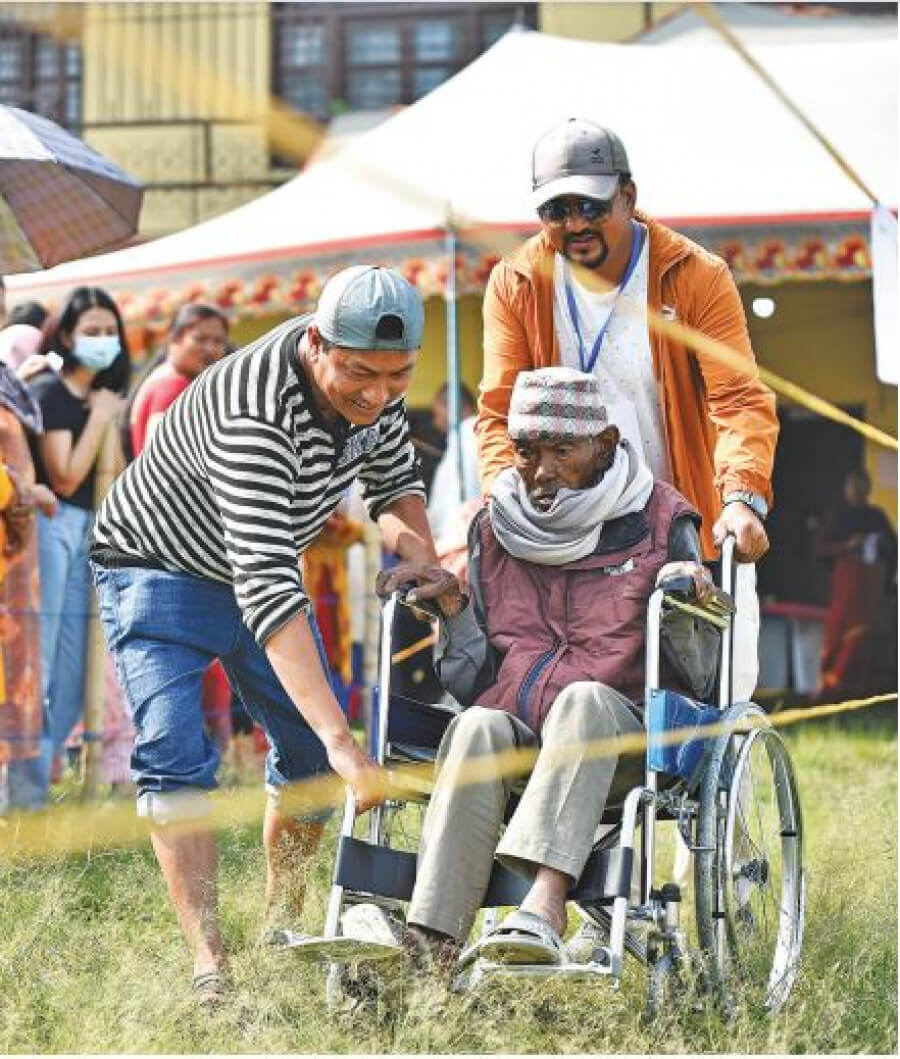
Transportation closure was one of the hurdles for people to come out and vote. Angad Dhakal/TKP
Nepalese in general love to vote.
Close to three fourths of eligible voters exercised their franchise in the previous local elections held in 2017. On an average, 74.16 percent voter turnout was reported in the local polls that were held in three phases.
Five years later, however, the voter turnout dwindled significantly when the country voted for the second local level elections on Friday.
Of the 17.73 million registered voters, only 64 percent cast their ballots, though the Election Commission says it could go up by a few percentage points after the final tally.
If the voter turnout stands at 64 percent, it will be the lowest since the 2008 Constituent Assembly elections when the voter turnout stood at 61.69 percent. The highest voter turnout reported since the 1991 elections was in the second Constituent Assembly in 2013 when 78.74 percent of listed voters exercised their franchise.
“An unexpectedly smaller number of voters cast their ballots, though we expect there will be an increase from 64 percent by the time we get the final report,” said Dinesh Thapaliya, the chief election commissioner.
Thapaliya said as high numbers of government staff were deployed to hold the elections, they couldn’t cast their votes from their respective local level. Same was the case with the thousands of election observers. One can cast their votes only from where they are registered. Government officials, security personnel and observers deployed in the areas other than where they are registered were unable to cast their votes. Close to 300,000 officials and security personnel were deployed to hold the polls while over 40,000 were deputed as observers.
However, observers say the reasons are more than what Thapaliya gave.
Kapil Shrestha, chairperson of the National Election Observation Committee, said the main reason behind the lower voter turnout is irresponsible statements from political leaders who threatened the people.
For instance, in his address during a mass meeting held on May 5 in Bharatpur, CPN (Maoist Centre) chairperson Pushpa Kamal Dahal warned the country would fall into a crisis if the people didn't vote for Renu Dahal, his daughter who is a mayoral candidate from the Maoist Centre in the metropolis. She is a common candidate of the five ruling parties in the metropolitan city.
In a separate poll rally in Dadeldhura the same day, Nepali Congress Central Working Committee member Arzu Rana Deuba, who is also the wife to Prime Minister Sher Bahadur Deuba, said the government will not release funds to the local governments where the candidates from her party are defeated.
“Such speeches created an environment of fear as well as rage,” said Shrestha. “The intervention from the centre for candidate selection also discouraged many people from voting.”
The parties finalised the candidates from the centre against the recommendations from the lower and district committees.
Another reason could be the lack of enthusiasm and curiosity like in the previous elections, which were held in 2017 after a gap of 20 years.
Election experts also blame alliance politics for the drop in voter turnout.
Dolakh Bahadur Gurung, a former election commissioner, said as there was an electoral alliance in many local units, committed cadres of the parties were reluctant to vote in the local units where there was no candidate from their party for major positions.
The five ruling parties—Nepali Congress, CPN (Maoist Centre), CPN (Unified Socialist), Janata Samajbadi Party and Rastriya Janamorcha—contested the local polls by forming alliances in many local units. Similarly, the CPN-UML joined its hands with the Rastriya Prajatantra Party Nepal and Pariwar Dal in some of the local units.
Gurung also blames the lack of proper security arrangements for the poor presence of voters. “It is unfortunate that so many cases of violence and clashes were reported though there were no armed outfits or the parties boycotting the elections [this time],” he said. “I think the plan to hold the local elections in a single phase was not a good idea.”
No local elections after 1990 have been held in a single phase. The 2017 local elections were held in three phases. In 1997, the local polls were held in two phases. In 1992, the elections for the local bodies were held in two phases.
Thapaliya, the chief election commissioner, said they expected more people to go out and vote in Kathmandu city. Though the turnout in Kathmandu is at par with the national average of 64, it is lower than that of the previous elections. As many as 76 percent voters participated in the 2017 local elections in Kathmandu, according to the chief election officer in Kathmandu.
Shrestha, who is also a professor of political science at Tribhuvan University, said the shutdown of transportation, too, discouraged many voters. “Many people originally from the core of Kathmandu are living in the outskirts but are voters from the same old places. There was a problem for them in commuting,” he said. “Stopping vehicular movement is a wrong move.”
Observers say in many local federal units, polling centres are placed hours away from settlements. That, too, was a demotivating factor for many voters.
The failure of the candidates to inspire voters has also contributed to the low turnout, they say. “There is also frustration among the public that nothing much was done for them in the last five years. That too led to absenteeism in voting,” said Pradip Pokharel, chairperson of the Election Observation Committee, Nepal. “A proper study is needed to find out the exact reasons.”













